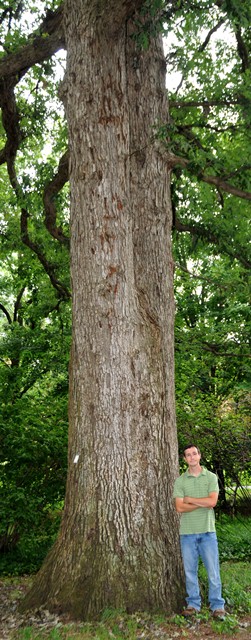Some of Maryland's Largest Trees Found at SU

SU's "Big Trees."
SALISBURY, MD---For years, Salisbury University has claimed championships in academic competitions and athletics. Now, it can claim champion trees, as well.
The Maryland Big Tree Program, in connection with the Maryland State Association of Forest Conservancy District Boards and Department of Natural Resources (DNR), recently declared three trees on SU’s campus as the largest of their species in the state. They include a Crimean linden (Tilia x euchlora) near the intersection of Camden and College avenues, a balsam fir (Abies balsamea) in front of the Camden House and a Korean pine (Pinus koraiensis) near Blackwell Library.
Through the program, volunteers travel the state to measure and catalog Maryland’s largest — and often oldest — trees. Each is assigned points based on the total circumference of its trunk, height and average crown spread.
The DNR’s Maryland Forest Service has been collecting data on the largest trees of each species growing in the state since 1925. All SU state record-holders will be nominated for inclusion in the National Register of Big Trees, an initiative of the conservation organization American Forests.
“Many of the trees this initiative has included began their growth a century or more ago,” said Will Lowery, SU senior horticulturist. “SU is proud to be included in this project.”
In addition to the state champions, five SU trees were named the largest of their species in Wicomico County. They included a white oak (Quercus alba) and black oak (Quercus velutina), both near the Guerrieri University Center, an American elm (Ulmus americana) and Japanese zelkova (Zelkova serrata) near Holloway Hall, and an eastern redbud (Cecis canadensis) in front of the Camden House.
The records, as well as photos of the champion trees, will be placed on the Maryland Big Trees Project Web site at www.mdbigtrees.com.
“Our historical trees and other plants help make the campus a beautiful place to study, to live, or to just stroll,” said Lowery. “We invite the community to come see our champions for themselves.”
Measurements of SU’s “big trees” are:
- American elm: 274 points, 162-inch circumference, 89 feet tall, 114-foot average crown width
- Black oak: 262 points, 183-inch circumference, 117 feet tall, 103.5-foot average crown width
- White oak: 262 points, 147-inch circumference, 97 feet tall, 73.5-foot average crown width
- Crimean linden: 252 points, 175-inch circumference, 59 feet tall, 70-foot average crown width
- Balsam fir: 211 points, 110-inch circumference, 90 feet tall, 44.5-foot average crown width
- Japanese zelkova: 161 points, 87-inch circumference, 58 feet tall, 62.5-foot average crown width
- Korean pine: 133 points, 82-inch circumference, 39 feet tall, 47-foot average crown width
- Eastern redbud: 70 points, 26-inch circumference, 37 feet tall, 26-foot average crown width
For more information call 410-543-6030 or visit the SU Web site at www.salisbury.edu.
